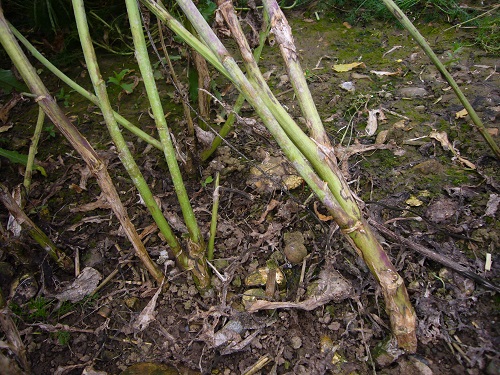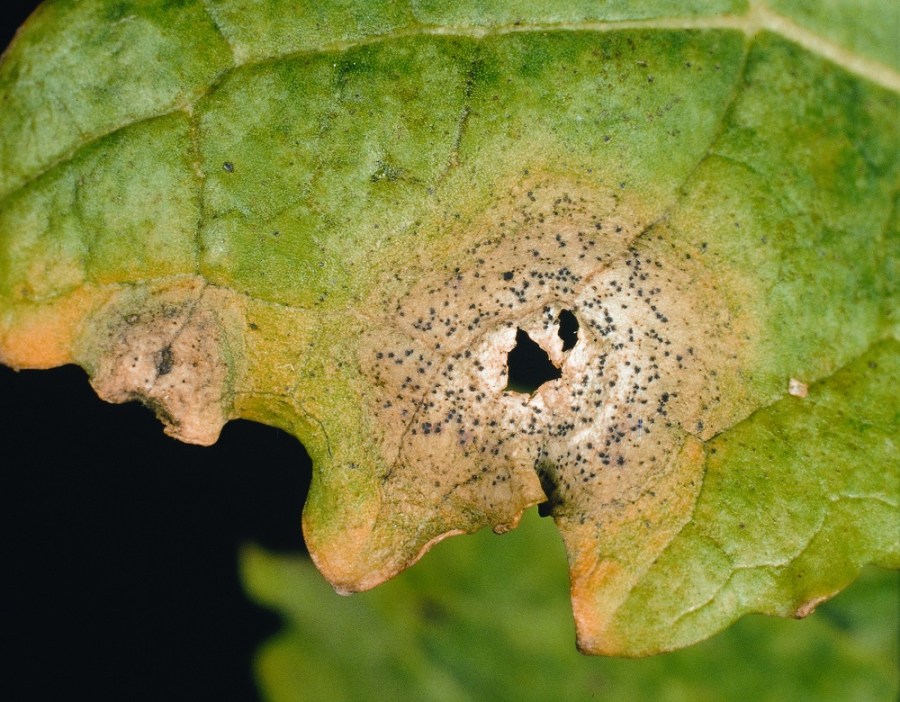Phoma may have assumed a lesser importance lately but the disease hasn’t gone away. CPM discovers more about the phoma pathogens, particularly Leptosphaeria biglobosa where plant resistance isn’t a factor.
L. biglobosa can dominate where an L. maculans resistant variety is used.
By Lucy de la Pasture
Over the past few seasons, light leaf spot (LLS) has usurped phoma stem canker as the number one disease of oilseed rape in the UK. The change is partially due to the introduction of improved resistance genes against the phoma pathogen in an increasing number of OSR varieties, as well as weather conditions that have been very favourable for LLS epidemics.
In spite of being relegated to second spot, the potential for phoma to cause devastating yield loss remains and it’s important not to take the eye off the ball where the disease is concerned, believes Dr Bruce Fitt, professor of plant pathology at University of Herts.

L. maculans causes basal stem cankers which can lead to lodging of the crop.
“Phoma stem canker is caused by two pathogens Leptosphaeria maculans and L. biglobosa. L. maculans is generally considered to be the more damaging of the two, causing stem-based cankers and L. biglobosa less so, because it tends to cause stem lesions higher up in the canopy,” he notes.
Phoma stem canker goes through one complete life cycle each cropping season and epidemics are initiated in the autumn by the release of airborne ascospores from crop debris.
“The timing of spore release is influenced by the weather conditions and if it’s wet in the period beginning 1 Aug, it tends to bring forward the release of ascospores. In a dry summer/autumn season, ascospore release will be delayed.”
Rothamsted Research produce a phoma forecast based on weather data to help predict likely timing of phoma leaf-spotting and improve consequent spray timing. The established threshold for fungicide treatment is when 10% of plants within a crop are affected by phoma leaf-spotting. Control using fungicides needs to be timely because it’s only possible during the early stages of phoma stem-canker epidemics, he adds.
“Once an OSR crop is infected, the phoma pathogen causes leaf spotting and eventually grows along the leaf petiole into the plant stem. Once within the plant stem, the fungi are beyond the reach of fungicides and they invade and kill stem cell tissues, resulting in the formation of phoma stem cankers,” explains Bruce.
The relative importance of L. maculans and L. biglobosa pathogens may vary between sites in the UK, but the focus from both plant breeders and fungicide manufacturers has been firmly on the former pathogen, with L. biglobosa assuming lesser importance.
“Many current varieties have major resistance gene Rlm7, which operates against infection at the leaf-spotting stage of the disease by the pathogen L. maculans. This is usually in combination with a quantitative resistance, based on multiple minor genes, which slow down the spread of the pathogen along the petioles and into the stems of OSR plants, as well as protecting the major resistance gene.
In field experiments carried out in the UK, researchers have shown amounts of L. biglobosa DNA were greater than those of L. maculans DNA, in both upper stem and stem-base samples. These results suggest that the severe upper stem lesions and stem-base cankers in the 2011/2012 cropping season were mainly caused by L. biglobosa, indicating that the pathogen can sometimes cause considerable yield losses, points out Bruce.
The researchers also noted differences between OSR cultivars in the incidence of L. maculans and L. biglobosa, suggesting that host resistance affects the population dynamics of the two different phoma pathogens. The amount of L. maculans DNA was less than L. biglobosa DNA in cultivars with the Rlm7 gene, but the other way around in susceptible varieties without resistance genes against L. maculans. “This suggests that L. biglobosa can dominate where an L. maculans resistant variety is used,” he explains.
Another piece of published research seems to indicate that L. biglobosa is less sensitive to some triazole fungicides than L. maculans, but it’s a subject under much debate, stresses Bruce.
Saving prothioconazole for light leaf spot control
In the field, where there’s a likely mixed population of pathogens, what approaches are agronomists taking to phoma control this autumn?
NIAB-TAG agronomist Jon Bellamy is advising growers with over 2800ha of OSR in Northants, Oxon and Bucks, and is acutely aware of the need to spread the fungicide workload with different active ingredients.
Having lost some actives from the market over the past few years, there were few options for effective autumn disease control. The introduction of some new products, including Refinzar (penthiopyrad+ picoxystrobin), has not only filled the gap but also taken disease management to a new level. Most importantly it means he’s not reliant on just one product alone.
With an increase in the incidence of LLS and multiple sprays commonly being applied, the overuse of Proline (prothioconazole) could lead to selection for fungicide insensitivity and a reduction in triazole efficacy, he points out.
Independent agronomist and AICC member Luke Cotton agrees with him. “Multiple applications in the autumn and spring of prothioconazole for phoma and LLS, especially on susceptible OSR varieties, has proved to be an expensive way of treating crops,” he says.
With both diseases regularly threatening the 1300ha of OSR across his farms, Luke believes that switching to an autumn application of Refinzar has benefitted his growers through the introduction of two new active ingredients.
Persistent control of both infections, combined with less overall fungicide applications, have meant a significant saving in both input and fixed costs, whilst taking the pressure off prothioconazole and allowing it to be saved for the spring.
“We were applying prothioconazole up to three times across the autumn and spring, and often disease control was compromised in a bad year. Although in susceptible varieties, early threshold recognition allowed us to keep on top of things, reinfection meant that repeated applications were often necessary.”
Saving prothioconazole for use later in the season is a tactic Jon is also employing. “In terms of efficacy, the Refinzar matches prothioconazole, so provides a robust and reliable platform for autumn disease control. This means we can preserve the prothioconazole almost exclusively for spring/summer use,” he explains.
“It’s now become a genuine treatment option for us with the high output varieties we’re now growing, such as Elgar, Flamingo and Nikita. And although we apply according to observed disease thresholds, it’s a really good fit for that type of variety’s disease strengths and weaknesses.”
Luke believes that using the combination of non-triazole actives has given more disease security, especially when used in conjunction with the more resistant varieties.
“It’s given us an ideal way of reducing the total number of fungicide applications while delivering other physiological benefits. If we’re mainly targeting phoma, it also takes care of any latent LLS infection.
“The SDHI element provides both sound protectant and curative activity on phoma leaf spotting and the subsequent reduction in stem canker. The strobilurin part also delivers longer-term protection and their combined physiological benefits can often result in greater root density and rooting depth.”
Jon regards any physiological benefits as an added bonus. “It’s difficult to try to quantify how much yield benefit is generated through enhanced growth and root establishment. But with levels of clubroot on the increase and potential damage from cabbage stem flea beetle, a stronger, healthier and more vigorous plant has got to be more resilient to infection or attack.”
He suggests that improved rooting could be a strategic option on lighter and more drought-prone soils, where enhanced root biomass is essential to prolong the life of the crop and reduce the likelihood of early senescence.
“Fungicide choice still comes down to getting effective control of both major diseases and a single treatment of between 0.5 l/ha and 0.75 l/ha should, depending on the variety, carry the crop through to the spring.”
Agrovista agronomist, Robert Wilkin believes fungicide application at the first signs of phoma leaf-spot infection and particularly when weather conditions are variable, can also mean significant control of LLS even though the symptoms may not be visible.
“My growers in N Yorks recognise the need to control infections of both phoma and LLS before weather conditions dictate otherwise,” he explains.
“We incubate leaves to ascertain latent LLS infection levels and like to apply product early enough to ensure good control. Fungicides are best used in a protective scenario and I often apply them in tandem with a boron supplement. If fungicides are left until inclusion with Kerb (propyzamide), it can be too late and put too much pressure on the fungicide.”
Phoma disease cycle
The disease cycle is similar for both pathogens, which survive over summer on crop debris, particularly the taproot and stem bases of OSR stubble, which become encrusted with black fruiting bodies.
Most fruiting bodies are initially the asexual structures that release rain-splash dispersed spores (conidia) but by late summer and into the autumn, the sexual stage occurs as small black spheres around 0.5mm in diameter.
These mature to release wind-dispersed spores (ascospores) after rain or wetting by dew. The ascospores can blow long distances but most are deposited within 300m of the source. Ascospores deposited on leaves of new crops germinate in moist conditions and infect leaves via stomata and wounds, leading to small pale lesions (phoma leaf spot) that appear 7-15 days after infection depending on temperature.
The pale lesions develop black specks, which are additional asexual fruiting bodies that release splash-dispersed spores. Lesions of L. biglobosa are usually smaller and darker in appearance but both types vary according to interactions with the cultivar and recent weather.
From phoma leaf spot lesions, the fungus grows symptomlessly through the leaf to the stem, where it incubates until early spring when rapid growth by the fungus produces a visible stem rot or canker. Severe cankers cause early senescence and lodging but in UK conditions, cankers do not reduce yield unless they expand to girdle at least half the stem by late May.
Source: Croprotect, Rothamsted Research




